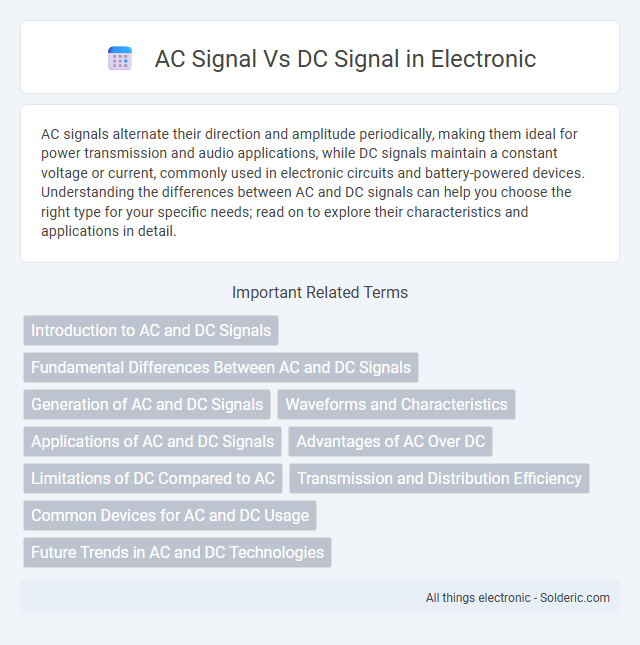AC signals alternate their direction and amplitude periodically, making them ideal for power transmission and audio applications, while DC signals maintain a constant voltage or current, commonly used in electronic circuits and battery-powered devices. Understanding the differences between AC and DC signals can help you choose the right type for your specific needs; read on to explore their characteristics and applications in detail.
Comparison Table
| Feature | AC Signal | DC Signal |
|---|---|---|
| Definition | Alternating Current; voltage or current reverses direction periodically | Direct Current; voltage or current flows in a single direction |
| Waveform | Sinusoidal or other periodic waveforms | Constant and steady |
| Frequency | Non-zero frequency (e.g., 50Hz, 60Hz) | Zero frequency (steady value) |
| Applications | Power transmission, household electricity, AC motors | Electronics, batteries, DC motors, charging circuits |
| Transmission Efficiency | High efficiency over long distances using transformers | Less efficient for long-distance transmission |
| Conversion | Can be converted to DC using rectifiers | Can be converted to AC using inverters |
| Measurement Units | Voltage in Vrms, current in Arms | Voltage in Vdc, current in Adc |
| Signal Stability | Periodic variation; not constant | Stable and constant amplitude |
Introduction to AC and DC Signals
AC signals alternate their voltage polarity and current direction periodically, typically described by frequency measured in hertz (Hz), making them ideal for power distribution and efficient energy transfer over long distances. DC signals maintain a constant voltage polarity and current flow, providing stable and consistent electrical power essential for electronic devices and battery-operated systems. Understanding the fundamental differences in waveform, frequency, and application helps optimize their use in various electrical and electronic systems.
Fundamental Differences Between AC and DC Signals
AC signals alternate their magnitude and polarity periodically, typically in a sinusoidal waveform, which allows efficient transmission over long distances and easy voltage transformation. DC signals maintain a constant magnitude and polarity over time, providing stable and consistent voltage crucial for electronic circuits and battery-powered devices. The fundamental difference lies in AC's time-varying nature versus DC's steady-state behavior, impacting applications in power delivery, signal processing, and electronic device design.
Generation of AC and DC Signals
AC signals are generated using alternators or AC generators that rotate coils within magnetic fields to produce a sinusoidal voltage waveform. DC signals are produced by sources such as batteries, DC power supplies, or rectifiers that convert AC to DC by allowing current flow in a single direction. Your choice of AC or DC depends on the application requirements and the nature of the power source involved.
Waveforms and Characteristics
AC signals exhibit sinusoidal waveforms that periodically alternate polarity and amplitude, creating a continuous oscillation around zero voltage. DC signals maintain a constant voltage level, resulting in a flat, unchanging waveform with steady polarity over time. Understanding these waveform characteristics helps you select the appropriate signal type for applications requiring stable power (DC) or varying current flow (AC).
Applications of AC and DC Signals
AC signals power household appliances, industrial machinery, and electric grids due to their efficient transmission over long distances and ease of voltage transformation. DC signals are essential in electronic devices, battery-powered equipment, and renewable energy systems like solar panels where stable voltage output is critical. Both AC and DC signals are integral in electric vehicle systems, with AC used for motor drives and DC employed in battery storage and power management.
Advantages of AC Over DC
AC signals enable efficient long-distance power transmission with minimal energy loss due to easy voltage transformation using transformers. Alternating current systems support the operation of AC motors and appliances, which are generally more cost-effective and durable compared to DC counterparts. The inherent ability to change frequency and voltage in AC signals also facilitates grid stability and integration of renewable energy sources.
Limitations of DC Compared to AC
DC signals face limitations such as inability to efficiently transmit power over long distances due to constant voltage and current, causing significant energy loss as heat. Unlike AC signals, DC lacks easy voltage transformation using transformers, restricting adaptability in power distribution networks. Your power systems benefit from AC's flexibility and reduced transmission losses, making DC less practical for widespread energy delivery.
Transmission and Distribution Efficiency
AC signals enable efficient long-distance transmission due to easy voltage transformation using transformers, minimizing power loss during distribution. DC signals, while offering lower line losses over very long distances, require complex and costly conversion equipment for voltage change, limiting their widespread use in traditional power grids. Transmission efficiency for AC is enhanced by its ability to step up voltage and reduce current, whereas DC is preferred in specific high-voltage direct current (HVDC) applications to achieve optimal efficiency in particular scenarios.
Common Devices for AC and DC Usage
Common devices using AC signals include household appliances like refrigerators, air conditioners, and lighting systems, which rely on the alternating current supplied by power grids. DC signals power devices such as smartphones, laptops, and electric vehicles, utilizing batteries or DC power supplies for consistent voltage output. Your ability to select the appropriate device depends on understanding the application requirements for either AC or DC signals in their operation.
Future Trends in AC and DC Technologies
Future trends in AC and DC technologies emphasize the integration of smart grids, enhancing energy efficiency and reliability through advanced power electronics and digital controls. Innovations in high-voltage DC (HVDC) transmission facilitate long-distance power delivery with reduced losses, supporting renewable energy integration and decarbonization goals. Emerging applications such as electric vehicle charging infrastructure and decentralized energy systems increasingly rely on hybrid AC/DC solutions to optimize performance and sustainability.
AC signal vs DC signal Infographic

 solderic.com
solderic.com